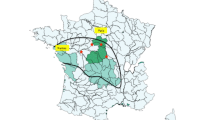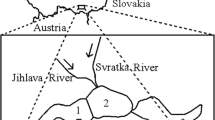Abstract
Twenty-three specific organochlorine contaminants and polychlorinated biphenyls (PCBs), measured as three Aroclor® standards were analyzed in muscle, liver, and ovaries of cod, Gadus morhua, collected in the Northwest Atlantic. In general, contaminants were undetectable in muscle tissue, while concentrations were 10 times lower in ovaries than liver (wet weight). Comparison of results to other locations indicated a similarity between the ratio of the concentrations of p,p′-DDE, p,p′-DDD and p,p′-DDT, in liver of cod from the northern North Sea and from the Northwest Atlantic, although with lower levels in the present study. The ratio of α-HCH and γ-HCH was between that of the central and northern North Sea. Similar ratios tend to indicate similar residence times in the atmosphere, from source to sampling area. Comparison of ∑PCB and ∑DDT in the liver of cod from various geographical locations showed the following general trend in concentrations: Arctic, Northwest Atlantic, West Atlantic, Norway < North Baltic, Nova Scotia, North Sea < South Baltic. It was observed that if the liver concentration of one compound was low (high), there was a tendency for all compounds to be low (high). Cluster analysis of organochlorines in liver pointed to the presence of four basic clusters, which could reflect similar physical chemical properties within a group. Concentrations of organochlorines in ovaries were below levels expected to affect egg and larval viability.
Similar content being viewed by others
References
Addison RF (1989) Organochlorines and marine mammal reproduction. Can J Fish Sci 46:360–368
Allison D, Kallman BJ, Cope OB, van Valin CC (1964) Some chronic effects of DDT on cutthroat trout. US Fish Wild Serv Res Rep 64:1–30
Anderson O, Linder C-E, Olsson M, Reutergardh L, Uvemo U-B, Wideqvist U (1988) Spatial differences and temporal trends of organochlorine compounds in biota from the northwest hemisphere. Arch Environ Contam Toxicol 17:755–765
Barrie LA, Gregor D, Hargrave B, Lake R, Muir D, Shearer R, Tracey B, Bidleman T (1992) Arctic contaminants: Sources, occurrence and pathways. Sci Tot Environ 122:1–74
Bidleman TF, Christensen EJ, Billings WN, Leonard R (1981) Atmospheric transport of organochlorines in the North Atlantic gyre. J Mar Res 39:443–464
Black DE, Phelps DK and Lapan RL (1988) The effect of inherited contamination of egg and larval winter flounder, Pseudopleuronectes americanus. Mar Environ Res 25:45–62
Borrell A (1993) PCB and DDT in blubber of cetaceans from the Northeastern North Atlantic. Mar Pollut Bull 26:146–151
Casillas E, D Misitano, LL Johnson, LD Rhodes, TK Collier, JE Stein, BB McCain, and U Varanasi (1991) Inducibility of spawning and reproductive success of female English sole (Parophrys vetulus) from urban and nonurban areas of Puget Sound, Washington. Mar Environ Res 31:99–122
Collier TK, Stein JE, Sanborn HR, Hom T, Myers MS, Varanasi U (1992) Field studies of reproductive success and bioindicators of maternal contaminant exposure in English sole (Parophrys vetulus). Sci Tot Environ 116:169–185
de Boer J (1988) Trends in chlorobiphenyl contents in livers of Atlantic cod (Gadus morhua) from the North Sea, 1979–1987. Chemosphere 17:1811–1819
— (1989) Organochlorine compounds and bromodiphenyl ethers in livers of Atlantic cod (Gadus morhua) from the North Sea, 1977–1987. Chemosphere 18:2131–2140
Ecobichon DJ, Joy RM (1982) Pesticides and neurological diseases. CRC Press, Boca Raton, FL 281 pp
Elliott JE, Norstrom RJ, Keith JA (1988) Organochlorines and eggshell Thinning in Northern Gannets (Sula bassanus) from Eastern Canada 1968–1984. Environm Pollut 52:81–102
El Shaarawi H, Naderi A (1991) Statistical inference for multiply censored environmental data. Environ Monit Assess 17:339–347
Environmental Protection Agency (1980) Ambient water quality criteria document. US Fed Reg 50:1170–1176
Falandysz J (1984) Organochlorine pesticides and polychlorinated biphenyls in livers of cod from the Southern Baltic, 1981. Z Lebensm-Unters-Forsh 179:311–314
— (1986) Organochlorine pesticides and polychlorinated biphenyls in cod from the Southern Baltic, 1983. Z Lebensm-Unters-Forsh 182:136–139
Freeman HC, Sangalang GB, Uthe JF, Garside ET, Daye PG (1983) A histopathological examination of and analysis of polychlorinated hydrocarbons in inshore Atlantic Cod (Gadus morhua). Arch Environ Contam Toxicol 12:627–732
GESAMP, Joint group of experts on the scientific aspects of marine pollution (1990) Review of potentially harmful substances, choosing priority organochlorines for marine hazard assessment. Reports and studies, no 42, 13 pp
Haati H, Pertilla M (1988) Levels and trends of organochlorines in cod and herring in the Northern Baltic Mar Pollut Bull 19:29–32
Hansen P-D, von Westernhagen H, Rosenthal H (1985) Chlorinated hydrocarbons and hatching success in Baltic herring spring spawners. Mar Environ Res 15:59–76
Hayes WJ Jr (1975) Toxicology of pesticides. Williams and Wilkins, Baltimore, 580 pp
Hellou J, Stenson G, Ni IH, Payne JF (1990) Polycyclic aromatic hydrocarbons in muscle tissue of marine mammals from the Northwest Atlantic. Mar Pollut Bull 21:469–473
Hellou J, Upshall C, Ni IH, Payne JF, Huang YS (1991) Polycyclic aromatic hydrocarbons in harp seals (Phoca groenlandica) from the Northwest Atlantic. Arch Environ Contam Toxicol 21:135–140
Hellou J, Upshall C, Payne JF, Naidu S, Paranjape MA (1993a) Total unsaturated compounds and polycyclic aromatic hydrocarbons in invertebrates from waters around Newfoundland. Arch Environ Contam Toxicol 24:249–257
Hellou J, Upshall C, Payne JF, Hodson PV (1993b) Polycyclic aromatic compounds in cod (Gadus morhua) from the Northwest Atlantic and the St-Lawrence estuary. Sci Tot Environ (in press)
Hellou J, Fancey LL, Payne JF (1993c) Concentrations of 24 elements in bluefin tuna, Thunnus thynmus from the Northwest Atlantic. Chemosphere 24:211–218
Hellou J, Warren WJ, Payne JF, Belkhode S, Lobel P (1993d) Heavy metals and other elements in three tissues of cod Gadus morhua from the Northwest Atlantic. Mar Pollut Bull 24:452–458
Hellou J, Payne JF (1993e) Polychlorinated dibenzo-p-dioxins and dibenzofurans in cod (Gadus morhua) from the Northwest Atlantic. Mar Environ Res (in press)
Hogan JW, Brauhn JL (1975) Abnormal rainbow trout fry eggs containing high residues of a PCB (Aroclor 1242). Prog Fish Cult 37:229–230
Ingebrigtsen K, Solbakken JE (1985) Distribution and elimination of [14C]-hexachlorobenzene after single exposure in cod (Gadus morhua) and flounder (Platichthys flesus). J Toxicol Environ Health 16:197–205
Joliffe IT (1970) Redundant variables in multivariate analysis. PhD Thesis, University of Sussex
Joy RM (1982) Chlorinated hydrocarbon insecticides, In: Ecobichon DJ, Joy RM (eds) Pesticides and neurological diseases. CRC Press Inc, Boca Raton, FL pp 91–150
Julshamn K, Braekkan OR (1978) The relation between the concentration of some main elements and the stages of maturation of ovaries in cod (Gadus morhua). Fisk Dir Skr Ser Ernoering 1:1–15
Kannan K, Falandysz J, Yamashita N, Tanabe S, Tatasukawa R (1992) Temporary trends of organochlorine concentrations in cod-liver oil from the Southern Baltic proper, 1971–1989. Mar Pollut Bull 24:358–363
Koistinen J, Paasivirta J, Vuorinen PJ (1989) Dioxins and other planar polychoroaromatic compounds in Baltic, Finnish and Arctic fish samples. Chemosphere 19:527–530
Luckas B, Vetter W, Fisher P, Heidemann G, Plotz J (1990) Characteristic chlorinated hydrocarbon patterns in the blubber of seals from different marine regions. Chemosphere 21:13–19
Muir DCG, Norstrom RJ, Simon M (1988) Organochlorine contaminants in Arctic marine food chains: Accumulation of specific polychlorinated biphenyls and chlordane related compounds. Environ Sci Technol 22:1071–1079
Muir DCG, Wageman R, Grift NP, Norstrom RJ, Simon M, Lien J (1988b) Organochlorines chemical and heavy metals contaminants in white-beaked dolphins (Lagenorhynchus albrostris) and pilot whales (Globicephala melaeans) from the coast of Newfoundland, Canada. Arch Environ Contam Toxicol 17:613–629
Muir DCG, Wageman R, Hargrave BT, Thomas DJ, Peakall DB, Norstrom RJ (1992) Arctic marine ecosystem contamination. Sci Tot Environ 122:75–134
Niimi AJ (1987) Biological half-lives of chemicals in fishes. In: Ware GW (ed) Reviews of environmental contamination and toxicology. Springer-Verlag, NY, Vol 99, pp 1–46
Nelson DA, Miller JE, Rusanowsky D, Greig RA, Sennnefelder GR, Mercaldo-Allen R, Kuropat C, Gould E, Truberg FP, Calabrese A (1991) Comparative reproductive success of winter flounder in Long Island Sound: A three-year study (biology, biochemistry and chemistry). Estuaries 14:318–331
Paasivarta J and Rantio T (1991) Chloroterpenes and other organochlorines in Baltic finfish and Arctic wildlife. Chemosphere 22:47–55
Preston MR (1992) The interchange of pollutants between the atmosphere and oceans. Mar Pollut Bull 24:477–483
Schmitt CJ, Zajicek JL, Peterman PH (1990) National contaminant biomonitoring Program: Residues of organochlorines in US fresh-water fish, 1976–1984. Arch Environ Contam Toxicol 19:748–781
Schneider R (1982) Polychlorinated biphenyls (PCB) in cod tissues from the Western Baltic: Significance of equilibrium partitioning and lipid composition in the bioaccumulation of lipophilic pollutants in gill-breathing animals. Rep Mar Res 29:69–79
Scott JF (1972) Redundant variables in multivariate analysis. In: Third conference of the advisory group of forest statisticians, Jouy-en-Josas, Sep 7–11 1970. Institut National de la Recherche Agronomique. Paris, France, Publ 73–3, pp 153–159
Skare JU, Stenersen J, Kveseth N, Polder A (1985) Time trends of organochlorine chemical residues in seven sedentary marine fish species from a Norwegian Fjord during the period 1972–1982. Arch Environ Contam Toxicol 14:33–41
Skinner L (1991) Results published in: Toxic chemicals in the Great Lakes and associated effects. Vol 1. Contaminants levels and trends. 489 pp
Spies RB, Rice DW Jr (1988) Effects of organic contaminants on reproduction of the starry flounder Platichthys stellatus in San Francisco Bay II Reproductive success of fish captured in San Francisco Bay and spawned in the laboratory. Mar Biol 98:191–200
Staveland G, Marthinsen I (1989) Growth, condition and PCB content of cod (Gadus morhua) and flounder (Platichthys flesus) in the Hvaler area, Southern Norway. ICES Marine Environmental Quality Committee, E:3, 14 pp
Stronkhorst J (1992) Trends in pollutants in blue mussel Mytilus edulis and flounder Platichthys fletus from two Dutch estuaries, 1985–1990. Mar Pollut Bull 24:250–258
Uthe JF, Chou CL, Musial CJ (1984) Research in fisheries contaminants and toxicology conducted by the contaminants research unit, Fisheries and Environmental Sciences Division, Halifax, Component, in 1983. Can Man Rep Fish Aquat Sci No 1757, 12 pp
Westernhagen HV, Rosenthal H, Dethlefsen D, Ernst W, Harms U, P-D Hansen (1981) Bioaccumulating substances and reproductive success in Baltic flounder Platichthys flesus. Aquat Toxicol 1:85–99
Westernhagen HV, Sperling KR, Janssen D, Dethlefsen V, Cameron P, Kocan R, Landolt M, Furstenberg G, Kremling K (1987) Anthropogenic contaminants and reproduction in marine fish. Der Biol Anstalt Helgoland, no 3, 70 pp
Wickstrom K, Pyysalo H (1981) Organochlorine compounds in liver of cod (Gadus morhua) in the Northern Baltic. Chemosphere 10:999–1004
Author information
Authors and Affiliations
Rights and permissions
About this article
Cite this article
Hellou, J., Warren, W.G. & Payne, J.F. Organochlorines including polychlorinated biphenyls in muscle, liver, and ovaries of cod, Gadus morhua . Arch. Environ. Contam. Toxicol. 25, 497–505 (1993). https://doi.org/10.1007/BF00214339
Received:
Revised:
Issue Date:
DOI: https://doi.org/10.1007/BF00214339




